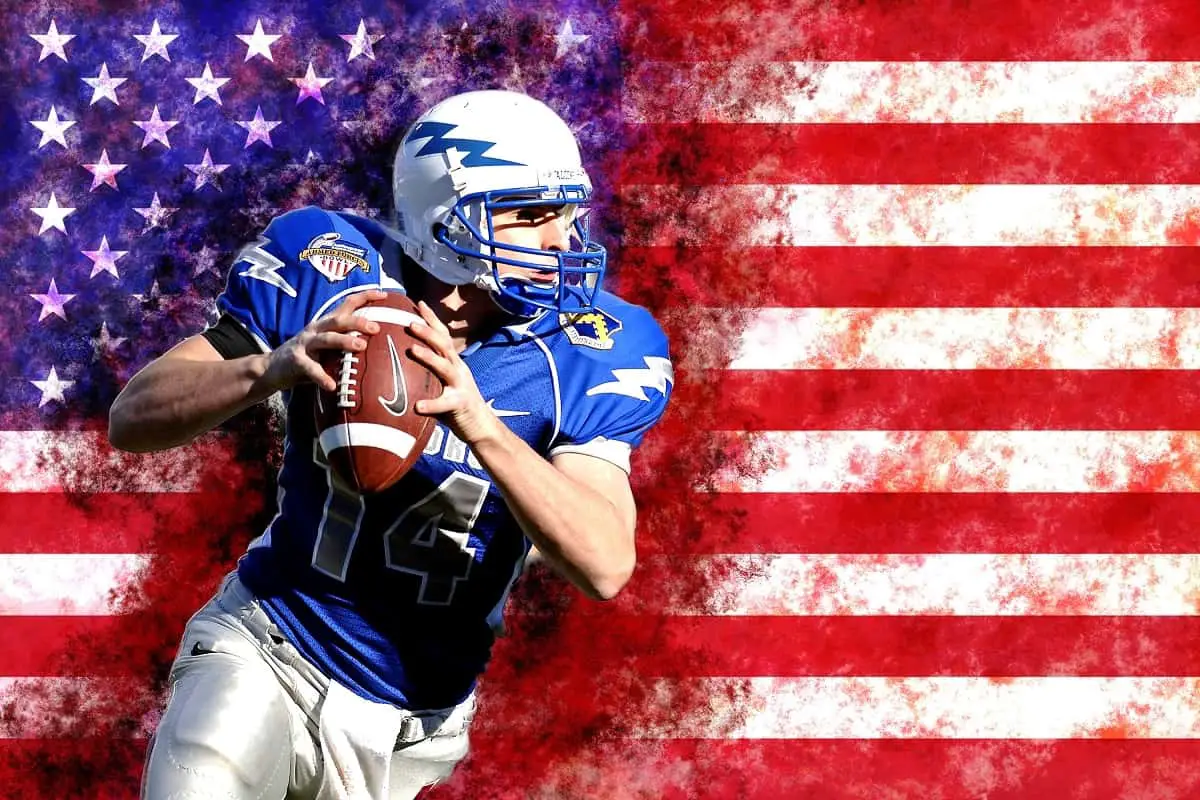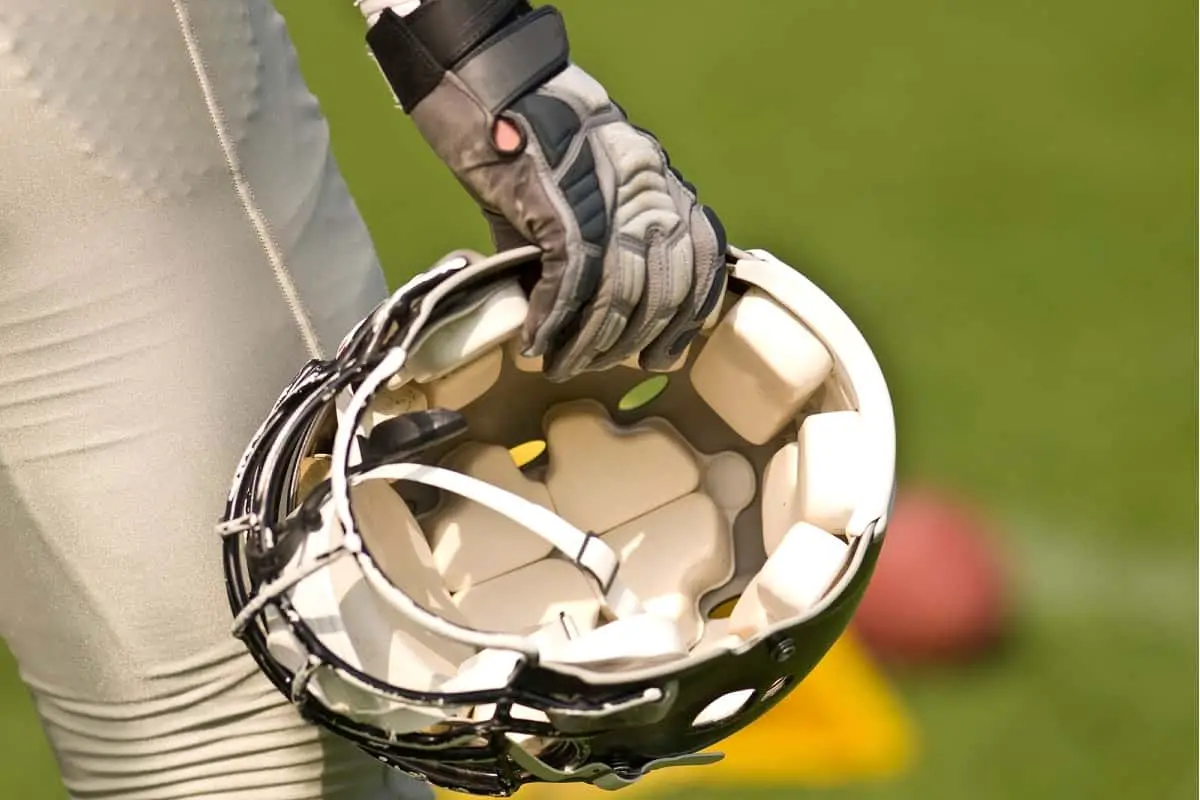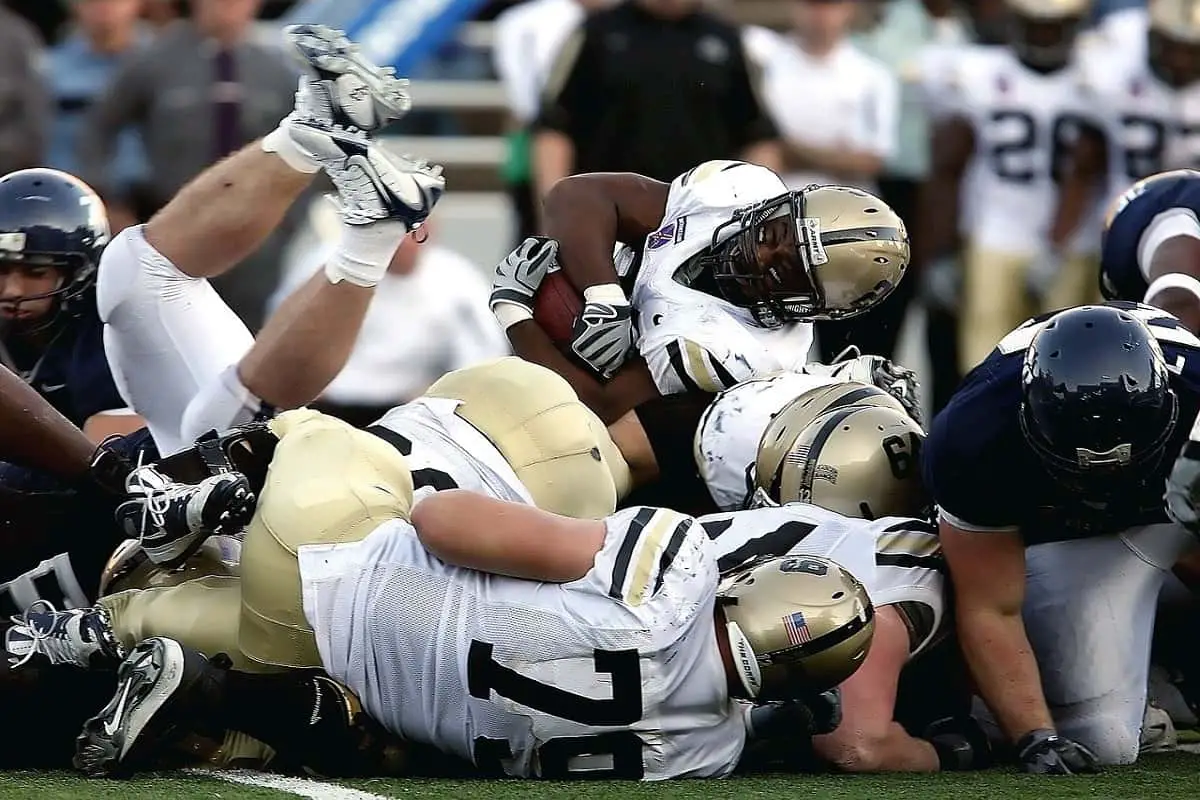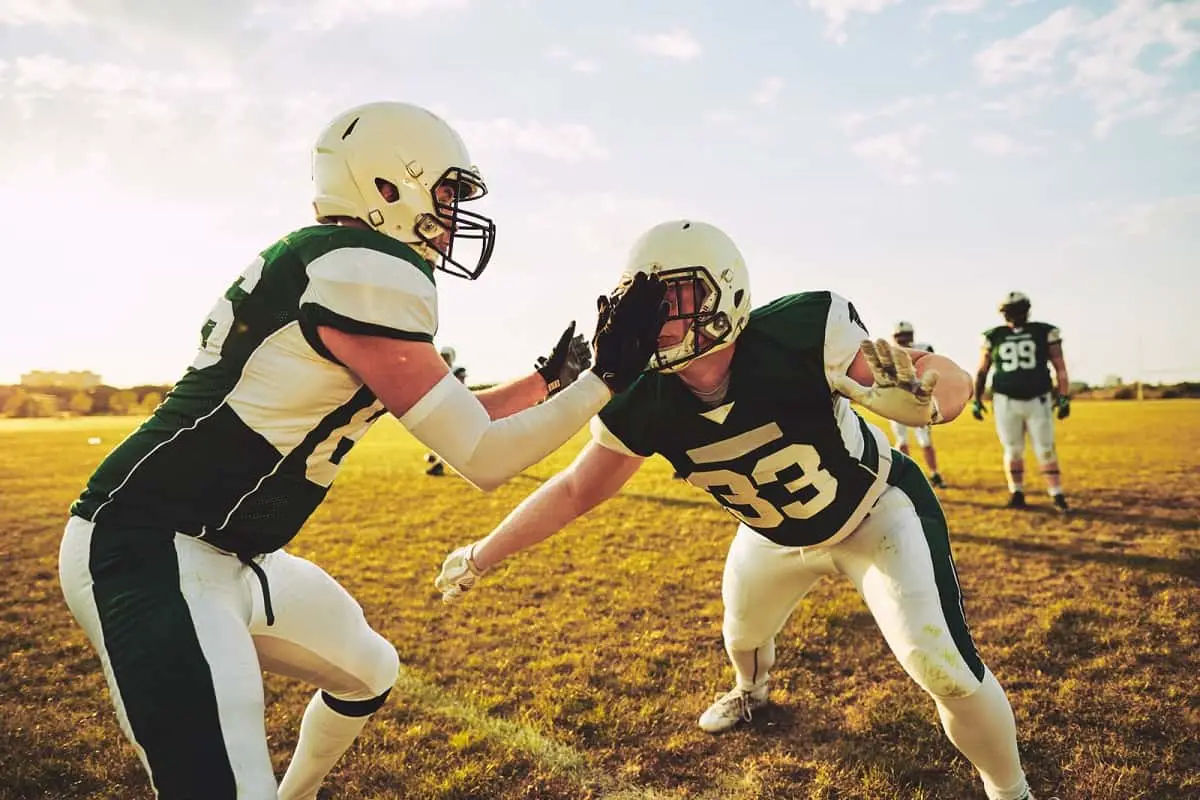What Are Football Helmets Made Of?
As a child, I recall watching in awe at American pro football players in their tight white trousers and their muscular shoulders running straight at their opponent like a charging bull. Then, crash! Ouch! That must have hurt.
But, they’d get up and get ready for another run at their opponent. I didn’t really notice that they were heavily padded, nor did I give much consideration to the role of the helmet.
If someone were to ask you ‘what are football helmets made of‘? Would you know the answer? With so many improvements to football helmets in recent years it’s hard to keep up with what they are anymore. Let’s take a look.
Page Content

Disclosure: As an Avantlink and Amazon Associate, we earn from qualifying purchases. Disclosure Statement.
What Are Football Helmets Made Of?
The first football helmet ever worn was made of leather, and was worn simply to protect the player’s ears. The modern football helmet is a far cry from that leather helmet of yesteryear. Like helmets worn in other contact sports, football helmets now incorporate a lot of modern technology to protect the head and brain from injury, as well as the ears, eyes, cheek bones, teeth, chin, etc.
First, there’s an outer shell made from molded polycarbonate. This outer shell has an interior lined with EPP (expanded polypropylene) or Thermoplastic Polyurethane (EPU), and Vinyl Nitrile (VN) foam for cushioning and comfort.
In addition, different manufacturers have their own added padding materials. Next is a titanium or carbon steel face mask. And finally, the chin strap.
The most important thing to understand about football helmets is that No Helmet Can Prevent Concussion! That said, it must also be understood that the objective of all helmet manufacturers is to produce a helmet that will decrease the chances of the wearer suffering from a severe head injury.
It is for that reason that helmet manufacturers have made significant advances in recent years to produce helmets with improved energy absorbing qualities.
You only need to compare the results of Virginia Tech’s football helmets test ratings from 2011 when only 1 helmet received the top five-star rating, or the results from 2012 with three 5-star helmets, or the 2014 result with 9 helmets scoring 5 stars, and the 2019 test results with a total of 21 five-star helmets.
That trend of improved safety has continued with the latest test results for 2023 showing 28 five-star helmets from several different helmet manufacturers.
Fantastic improvements in football helmet safety over a relatively short period of time.
And, the winners are . . . . the players wearing the helmets!
With the amount of research dollars invested into creating the ultimate in head protection for footballers, which is reflected in the retail prices of modern helmets, it is absolutely imperative that players at all levels take the time to maintain and care for their helmets like their life depended on it.
Time to take a closer look into these modern football helmets, but first let’s take a look at some amazing football helmets from yesteryear. Some of these, you will not believe!
The Evolution of American Football Helmets
Parts Of A Football Helmet
The Outer Shell
The outer shell is the part of the helmet that we can see when we are looking at the players. It is a thin but extremely hard material that protects the head from the brunt of a major impact. In adult helmets, it is made of molded polycarbonate due to it being lightweight, durable, and amazingly strong. This allows the players to be confident of their head being protected whilst at the same time being light enough to run fast.
Youth football helmets are made from ABS (Acrylonitrile Butadiene Styrene) as it is lighter than polycarbonate but still strong and durable. Polycarbonate helmets cannot be worn in youth leagues as the polycarbonate shell can seriously damage an ABS shell in a helmet to helmet impact.
Football Helmet Padding Materials
Inside the outer shell is usually an inner lining of EPP (expanded polypropylene). EPP is the perfect choice for a football helmet lining as it can take multiple impacts and return to its original shape. The EPP is complemented with VN (Vinyl Nitrile) foam which provides cushioning and comfort as well as shock absorption. VN is a blend of high-quality plastic and rubber, and is described as being practically indestructible.
Schutt Helmets, however, use TPU cushioning exclusively. TPU has the benefit of working better in extremes of temperature than other helmet liners. TPU has good elasticity qualities as well as being resistant to oils, grease and abrasion.
This content was originally published on headsdontbounce.com. If it appears on another website, it is a violation of the copyright owned by headsdontbounce.com.
Helmet manufacturers also add their own patented types of padding which are mainly air bubbles or bladders of varying methods which provide a custom fit and enhances comfort for the wearer. They also add a softer type of foam along the forehead and lower jaw to provide a more comfortable level of protection in those areas that receive less impact.

Facemask
The majority of modern facemasks are made from carbon steel, titanium or stainless steel. Carbon steel is the preferred material probably due to it being cheaper, however, it is strong but heavier than the other two choices. Stainless steel, whilst lighter and sturdier, is more costly than carbon steel.
In the NFL and other competitive adult leagues, titanium is the material of choice. Titanium is 45% lighter, more durable but the most expensive of the three. Regardless of what the facemask is made from, all facemasks are coated with Polyarmor G17, a durable powder coating with exceptional abrasion, impact and corrosion resistance qualities.
There are two main types of facemasks, the open cage, and the closed cage. The choice of the type of facemask depends on the position of the player. A wide receiver, defensive back or quarterback needs a clear vision to scan the entire field, so the open cage facemask is for them. A linebacker or fullback, on the other hand, will require a closed cage.
Chin Strap
Your Hi-Tech helmet shell, liner, padding and face-mask provides no protection at all without a chin strap that is as equally up to the job as every other part of your helmet. A sub-par chin strap could mean the difference between adequate head protection and your helmet flying off your head at a crucial moment.
Chin straps for football helmets are almost an industry in itself. There are numerous variables that can be considered when buying or replacing a chin strap.
First, there is the strap itself, which needs to be strong and durable. The strap is often made from leather or strong nylon. The strap can have plastic buckles and/or metal snaps to connect to the helmet. The most important part is the ‘cup’ which cradles the chin. The cup can be made of polycarbonate or ABS, it can be a soft cup or a hard cup.
Soft cups basically do no more than keep the helmet in place, whereas the hard cup also provides protection from impacts. Inside the cup is either foam padding or gel, or sometimes both to make the chin guard comfortable. The chin guard should also have air vents to help keep the chin dry and comfortable.

New Football Helmet Technology
Without doubt, the best thing to have happened in recent years for helmet safety has been the testing and ratings done by Virginia Tech. Not only for football helmets, but many different types of helmets, including cycling, ski helmets, equestrian helmets, and many more.
You can see clearly from what I wrote above where in 2011 there was only one football helmet that rated 5-star, how that number increased each year as manufacturers scrambled to improve their standing. I expect that will continue in the years ahead as manufacturers try not only to maintain their 5-star rating, but strive to improve their score and standing on the list.
Keep in mind that what the manufacturers need to aim for is better impact absorbing qualities of their products. Which means researching different materials, and exploring different possibilities.
Microlattice
One such material that we will hear more about is elastic microlattice. In the December 2019 issue of Matter journal an article was published detailing the amazing properties and potential of elastic microlattice as a possible helmet padding to reduce head injuries.
Their research found that the microlattice material achieved ‘up to a 27% improvement over the best-performing foam (EPS) in a single-hit scenario, and achieved up to a 48% improvement over the state-of-the-art VN foam in a multi-hit scenario’. That certainly sounds promising.
Vicis
This next one isn’t something that’s coming in the future, this one is here now. It is the perfect example of thinking outside the box and exploring different possibilities. Everyone knows that the outer shell of any protective helmet must be hard, like polycarbonate, right? Wrong! Enter Vicis Helmets.
Vicis Helmets entered the market about 6 years ago with a new concept in helmet design. The outer shell on a vicis helmet collapses like a car bumper then springs back into shape again. Not only has this new concept been accepted into the NFL, but it is also being rated by Virginia Tech where it received several 5-star ratings in the most recent ratings.
If you’re not familiar with Vicis, you must watch this video and be amazed.
NFL Using The VICIS ZERO1 Football Helmet That Morphs On Impact To Reduce Head Injuries
Guardian Cap
With football helmet technology continually improving, the NFL has seen the number of concussions reducing over recent years with only 187 concussions reported in the 2021 season. That’s a drop of around 30% on the previous year.
The NFL’s focus on reducing head injuries continues in 2022 as the NFL introduced a resolution in March which requires player in certain positions to wear Guardian Caps. Guardian Caps are a type soft padding that is worn on the outside of the helmet.
Guardian makes no claims that the Cap will stop or reduce concussion, only that the Cap is ‘impact reducing’. The NFL’s mandate is only for preseason training and up to the second preseason game.
Do Football Helmets Prevent Concussions?
I said it earlier in this article, and I’ll say it again here, no helmet can prevent concussion!
Conclusion
It would seem fair to say that the NFL are working hard to protect players and reduce concussions, and the steps taken to date are working. Most likely we can expect to see further improvements in football helmet technology making them safer than ever before.
With so many football helmets being rated 5-star in the Virginia Tech testing, then there is no reason why anyone should purchase a helmet that is less than 5-star.

Related Reads:
I hope we have covered the question of ‘what are football helmets made of’ to your satisfaction.
If you liked this post, why not share it with your friends.
